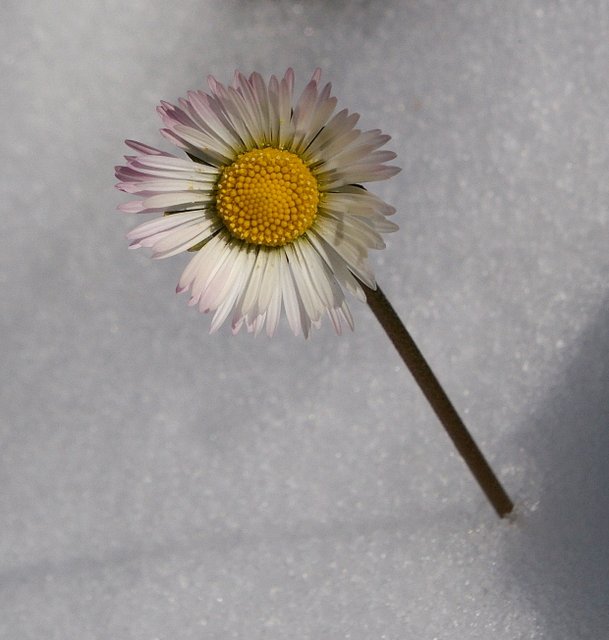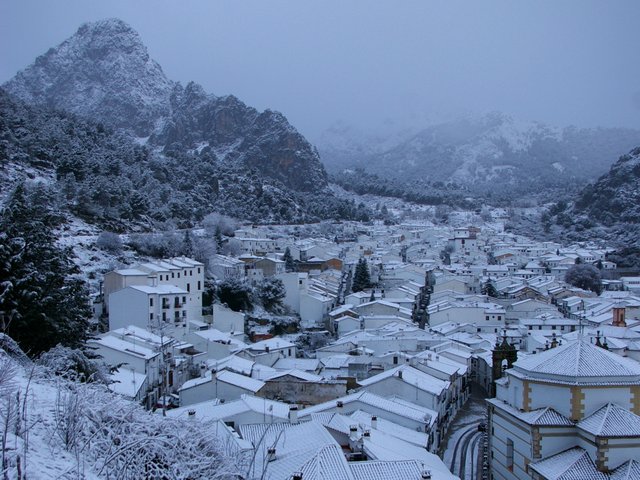The last weeks, the snow has been weather protagonist in Spain, because it is so rare that it appears in November, when usually falls in December or in January. As has dropped enough snow, the ski resorts have advanced opening and cities such as Madrid and Alicante are stained white. Some people has thought: If snow is frozen water, why it is white and not transparent, like ice?. Do you know it?. I did not know it ; but now I want to share with you my surprise -- if you did not know either the answer --.
Snow consists of flakes, which are crystals of frozen water around a speck of dust. They have a star-shaped with six arms and each consists of about a quintillion molecules. Clouds are formed in saturated water drops, whose temperature drops to -12 º C. As the flakes are adding including trapped air. Is that air which gives the white snow.
That air scatters light, ie, absorbs and then emits in all directions like billiard balls. The light is white because it is the sum of all colors of the rainbow: red, orange, yellow, green, blue and violet. Air is composed of molecules of oxygen, nitrogen and noble gases and particulate matter such as dust, drops and crystals of water and salt.

Here you can see the crystals of the snow.The flower is the "Winter daisy"
Each of the elements of the air scatter light in a particular color, on its merits. That is, each has a preference for any color, that make up light that strikes them, and separates it from others. For example, nitrogen and oxygen scatter more blue and violet color, emitting in all directions, while letting pass the remains of the colors straight. We see the blue rays fired in all directions.
However, the air enclosed in as little space, as is left between snowflakes, is different from that produced through blue sky. Under these conditions of confinement are also scattered colors but the human eye can not see the color selection of the different elements. We see the light again mixed, ie, white.
This same effect occurs for example with the hair of polar bears. Their robe is not snowy, but transparent. Is air trapped between the hairs, which gives white color when air diffuses light, as in the snow.
That same air, that gives the snow white colored, gives another feature: the relaxing effect. We who live in the city we note with particular intensity that snow brings calm itself. The atmosphere of the city becomes silent. Not because the cars go slower or have less people walking. What happens is that the snow muffles the sound. Air hosting flakes inside adds that gets trapped in the curd snow, that hides abundant cavities, that hide much air yet.
In Spain , precipitations as snow are most common above 2,500 meters . In January and February, the most snowfall are recorded.

Grazalema (Cádiz) is located 812 meters. A significant snowfall on a very nice village
The Meteorologist, José Miguel Viñas, has traveled from town to town in search of ecclesiastical and municipal archives, where you can view the most memorable snowfall occurred in our country , noted in his book ' The Science of Time ' (Ed. Almuzara ) . The biggest so far has been the " big snowfall of 1888 " or "the monumental of the three eights ": it snowed continuously in the north , especially in Asturias , between 14 and 29 of February . In the village of Pajares, were accumulated up to 5 meters from the meteor. When rescue units arrived matched to know that there was a village by the chimneys protruding . Another was the eternal snowfall of the Cantabrian town of Reinosa, where it snowed 62 days, non-stop, in 1917. An unusual snowfall, was which fell in Mallorca, in January 1967, which led to removing snow from roofs to prevent collapse . The heaviest snowfall, in the city of Madrid, took place in November 1904. Five feet of snow were accumulated. The last big snowfall, in Barcelona, took place the timely Christmas Day 1962.
I found very interesting this news and I wanted to share it with you; I hope that you have liked it such as I did.
Till soon, kind regards,
Luis.
Sponsored by Costaluz Lawyers.
Please click down here:
